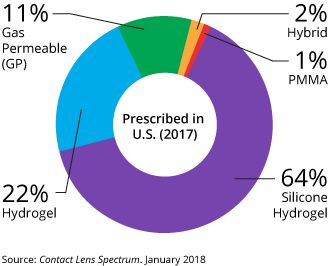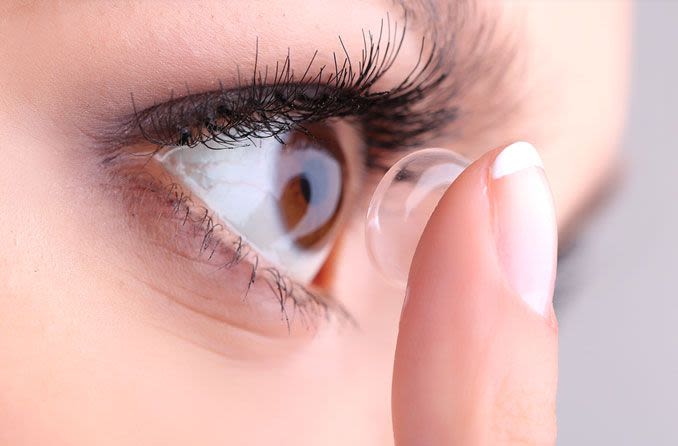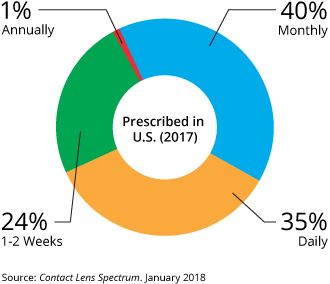Contact lenses are an excellent choice for nearly anyone who needs vision correction and doesn’t want to wear eyeglasses full time or undergo LASIK surgery.
Unsure about contact lenses? This article will detail contact lens materials, contact lens designs and features and even new contact lens formats.
For instance, the first light-adaptive contact lenses, Acuvue Oasys with Transitions, debuted in the United States in 2019 and contact lenses embedded with antibiotics are in the works. (See our contact lens news page for the latest in contact lenses.)
Here are the basics you should know about contact lenses before seeing your eye doctor if you are interested in wearing contacts.
Contact Lens Materials
The first choice when considering contact lenses is which lens material will best satisfy your needs. There are five types of contact lenses, based on type of lens material they are made of:

Contact Lens Material
- Soft lenses are made from gel-like, water-containing plastics called hydrogels. These lenses are very thin and pliable and conform to the front surface of the eye. Introduced in the early 1970s, hydrogel lenses made contact lens wear much more popular because they typically are immediately comfortable. The only alternative at the time was hard contact lenses made of PMMA plastic (see below). PMMA lenses typically took weeks to adapt to and many people couldn’t wear them successfully.
- Silicone hydrogel lenses are an advanced type of soft contact lenses that are more porous than regular hydrogel lenses and allow even more oxygen to reach the cornea. Introduced in 2002, silicone hydrogel contact lenses are now the most popular lenses prescribed in the United States.
- Gas permeable lenses — also called GP or RGP lenses — are rigid contact lenses that look and feel like PMMA lenses (see below) but are porous and allow oxygen to pass through them. Because they are permeable to oxygen, GP lenses can be fit closer to the eye than PMMA lenses, making them more comfortable than conventional hard lenses. Since their introduction in 1978, gas permeable contact lenses have essentially replaced nonporous PMMA contact lenses. GP contacts often provide sharper vision than soft and silicone hydrogel contacts — especially if you have astigmatism. It usually takes some time for your eyes to adjust to gas permeable lenses when you first start wearing them, but after this initial adaptation period, most people find GP lenses are as comfortable as hydrogel lenses.
- Hybrid contact lenses are designed to provide wearing comfort that rivals soft or silicone hydrogel lenses, combined with the crystal-clear optics of gas permeable lenses. Hybrid lenses have a rigid gas permeable central zone, surrounded by a “skirt” of hydrogel or silicone hydrogel material. Despite these features, only a small percentage of people in the U.S. wear hybrid contact lenses, perhaps because these lenses are more difficult to fit and are more expensive to replace than soft and silicone hydrogel lenses.
- PMMA lenses are made from a transparent rigid plastic material called polymethyl methacrylate (PMMA), which also is used as a substitute for glass in shatterproof windows and is sold under the trademarks Lucite, Perspex and Plexiglas. PMMA lenses have excellent optics, but they do not transmit oxygen to the eye and can be difficult to adapt to. These (now old-fashioned) “hard contacts” have virtually been replaced by GP lenses and are rarely prescribed today.
In 2017, 64 percent of contact lenses prescribed in the U.S. were silicone hydrogel lenses, followed by soft (hydrogel) lenses (22 percent), gas permeable lenses (11 percent), hybrid lenses (2 percent) and PMMA lenses (1 percent).
Contact lens basics: Types of contact lenses and more

Contact lenses are an excellent choice for nearly anyone who needs vision correction and doesn’t want to wear eyeglasses full time or undergo LASIK surgery.
Unsure about contact lenses? This article will detail contact lens materials, contact lens designs and features and even new contact lens formats.
For instance, the first light-adaptive contact lenses, Acuvue Oasys with Transitions, debuted in the United States in 2019 and contact lenses embedded with antibiotics are in the works. (See our contact lens news page for the latest in contact lenses.)
Here are the basics you should know about contact lenses before seeing your eye doctor if you are interested in wearing contacts.
Contact Lens Materials
The first choice when considering contact lenses is which lens material will best satisfy your needs. There are five types of contact lenses, based on type of lens material they are made of:

Contact Lens Material
- Soft lenses are made from gel-like, water-containing plastics called hydrogels. These lenses are very thin and pliable and conform to the front surface of the eye. Introduced in the early 1970s, hydrogel lenses made contact lens wear much more popular because they typically are immediately comfortable. The only alternative at the time was hard contact lenses made of PMMA plastic (see below). PMMA lenses typically took weeks to adapt to and many people couldn’t wear them successfully.
- Silicone hydrogel lenses are an advanced type of soft contact lenses that are more porous than regular hydrogel lenses and allow even more oxygen to reach the cornea. Introduced in 2002, silicone hydrogel contact lenses are now the most popular lenses prescribed in the United States.
- Gas permeable lenses — also called GP or RGP lenses — are rigid contact lenses that look and feel like PMMA lenses (see below) but are porous and allow oxygen to pass through them. Because they are permeable to oxygen, GP lenses can be fit closer to the eye than PMMA lenses, making them more comfortable than conventional hard lenses. Since their introduction in 1978, gas permeable contact lenses have essentially replaced nonporous PMMA contact lenses. GP contacts often provide sharper vision than soft and silicone hydrogel contacts — especially if you have astigmatism. It usually takes some time for your eyes to adjust to gas permeable lenses when you first start wearing them, but after this initial adaptation period, most people find GP lenses are as comfortable as hydrogel lenses.
- Hybrid contact lenses are designed to provide wearing comfort that rivals soft or silicone hydrogel lenses, combined with the crystal-clear optics of gas permeable lenses. Hybrid lenses have a rigid gas permeable central zone, surrounded by a “skirt” of hydrogel or silicone hydrogel material. Despite these features, only a small percentage of people in the U.S. wear hybrid contact lenses, perhaps because these lenses are more difficult to fit and are more expensive to replace than soft and silicone hydrogel lenses.
- PMMA lenses are made from a transparent rigid plastic material called polymethyl methacrylate (PMMA), which also is used as a substitute for glass in shatterproof windows and is sold under the trademarks Lucite, Perspex and Plexiglas. PMMA lenses have excellent optics, but they do not transmit oxygen to the eye and can be difficult to adapt to. These (now old-fashioned) “hard contacts” have virtually been replaced by GP lenses and are rarely prescribed today.
In 2017, 64 percent of contact lenses prescribed in the U.S. were silicone hydrogel lenses, followed by soft (hydrogel) lenses (22 percent), gas permeable lenses (11 percent), hybrid lenses (2 percent) and PMMA lenses (1 percent).
LEARN MORE about the proper care of your contact lenses.
Contact Lens Wearing Time
Until 1979, everyone who wore contact lenses removed and cleaned them nightly. The introduction of “extended wear” enabled wearers to sleep in their contacts. Now, two types of lenses are classified by wearing time:
- Daily wear — must be removed nightly
- Extended wear — can be worn overnight, usually for seven days consecutively without removal
“Continuous wear” is a term that’s sometimes used to describe 30 consecutive nights of lens wear — the maximum wearing time approved by the FDA for certain brands of extended wear lenses
When To Replace Your Contact Lenses
Even with proper care, contact lenses (especially soft contacts) should be replaced frequently to prevent the build-up of lens deposits and contamination that increase the risk of eye infections.
Soft lenses have these general classifications, based on how frequently they should be discarded:

Lens Replacement Frequency
- Daily disposable lenses — Discard after a single day of wear
- Disposable lenses — Discard every two weeks, or sooner
- Frequent replacement lenses — Discard monthly or quarterly
- Traditional (reusable) lenses — Discard every six months or longer
Gas permeable contact lenses are more resistant to lens deposits and don’t need to be discarded as frequently as soft lenses. Often, GP lenses can last a year or longer before they need to be replaced.
The most frequently prescribed contact lens replacement schedule in the U.S. in 2017 was monthly (40 percent), followed by daily (35 percent), every one to two weeks (24 percent) and annually (1 percent).
LEARN MORE about the proper care of your contact lenses.
Contact Lens Designs
Soft contact lenses (both standard hydrogel and silicone hydrogel lenses) are available in a variety of designs, depending on their intended purpose:

Soft contact lens designs
- Spherical contact lenses have the same lens power throughout the entire optical part of the lens to correct myopia (nearsightedness) or hyperopia (farsightedness).
- Toric soft contact lenses have different powers in different meridians of the lens to correct astigmatism as well as nearsightedness or farsightedness. [Read more about toric contact lenses.]
- Multifocal contact lenses (including bifocal contacts) contain different power zones for near and far vision to correct presbyopia as well as nearsightedness or farsightedness. Some multifocal lenses also can correct astigmatism. [Read more about bifocal contacts.]
- Cosmetic contact lenses include color contacts designed to change or intensify your eye color. Halloween, theatrical and other special-effect contacts also are considered cosmetic lenses. A contact lens prescription is required for cosmetic contacts even if you have no refractive errors that need correction.
All of these lenses can be custom made for hard-to-fit eyes. Other lens designs also are available — including lenses fabricated for use in special situations, such as correcting for keratoconus.
More Contact Lens Features
Bifocal contacts for astigmatism. These are advanced soft contacts that correct both presbyopia and astigmatism, so you can remain glasses-free after age 40 even if you have astigmatism. [More about bifocal contact lenses for astigmatism.]
Contacts for dry eyes. Are your contacts uncomfortably dry? Certain soft contact lenses are specially made to reduce the risk of contact lens-related dry eye symptoms. [More about contact lenses for dry eyes.]
Colored lenses. Many of the types of lenses described above also come in colors that can enhance the natural color of your eyes — that is, make your green eyes even greener, for example. Other colored lenses can totally change the color of your eyes, as in from brown to blue.
Special-effect lenses. Also called theatrical, novelty, or costume lenses, special-effect contacts take coloration one step further to make you look like a cat, a vampire, or another alter-ego of your choice.
Prosthetic lenses. Colored contact lenses also can be used for more medically oriented purposes. Opaque soft lenses called prosthetic contacts can be custom-designed for an eye that has been disfigured by injury or disease to mask the disfigurement and match the appearance of the other, unaffected eye.
Custom lenses. If conventional contact lenses don’t seem to work for you, you might be a candidate for custom contact lenses that are made-to-order for your individual eye shape and visual needs.
UV-inhibiting lenses. Some soft contact lenses help protect your eyes from the sun’s ultraviolet rays that can cause cataracts and other eye problems. But because contacts don’t cover your entire eye, you still should wear UV-blocking sunglasses outdoors for the best protection from the sun.
Scleral lenses. Large-diameter gas permeable lenses called scleral contacts are specially designed to treat keratoconus and other corneal irregularities, as well as presbyopia.
Myopia control contacts. Special contact lenses are being developed to slow or stop the progression of nearsightedness in children. [More about myopia control.]
Which Contact Lens Is Right for You?
First, your contacts must address the problem that is prompting you to wear lenses in the first place. Your contact lenses must provide good vision by correcting your myopia, hyperopia, astigmatism, or some combination of those vision problems.
Second, the lens must fit your eye. To do that, lenses come in tens of thousands of combinations of diameter and curvature. Of course, not every lens brand comes in every “size.”
Your ECP is skilled in evaluating your eye’s physiology, and your eyesight, to determine which lens best satisfies the two criteria above.
Third, you may have another medical need that drives the choice of lens. For example, your ECP might pick a particular lens if your eyes tend to be dry.
Finally, consider your “wish list” of contact lens features — colors, for example, or overnight wear.
When you and your ECP decide on the right lens for you, you’ll be given a contact lens prescription. You’ll be able to buy a supply of lenses from your ECP or from the many other outlets that sell contact lenses. [For more on this, please read “Where’s the Best Place to Buy Contact Lenses?”]
Contact Lens Wear and Care
Caring for your contact lenses — cleaning, disinfecting and storing them — is much easier than it used to be.
A few years ago, you would have needed several bottles of cleaning products, and perhaps enzyme tablets, for proper care. Today, most people can use “multipurpose” solutions — meaning that one product both cleans and disinfects, and is used for storage.
People who are sensitive to the preservatives in multipurpose solutions might need preservative-free systems, such as those containing hydrogen peroxide. These do an excellent job of cleaning contacts, but it’s very important to follow the directions for using them. The solution should not come into contact with your eyes until soaking is complete and the solution is neutralized.
Of course, you can avoid lens care altogether by wearing daily disposable contact lenses.
Contact Lens Problems
Trial and error often is involved in finding the perfect lens for you. People react differently to various lens materials and cleaning solutions.
Also, the correct “parameters” of your lens — that is, power, diameter, and curvature — can be finalized only after you’ve successfully worn the lens. This is especially true for more complex fits involving extra parameters, such as with bifocals or toric contact lenses for astigmatism.
If you experience discomfort or poor vision when wearing contact lenses, chances are that an adjustment or change of lens can help.
Today, more contact lens choices than ever are available to provide comfort, good vision, and healthy eyes. If your eyes or lenses are uncomfortable or you are not seeing well, remove your lenses and visit your eye care professional to explore available remedies for contact lens discomfort.
Buying Contact Lenses
You can buy replacement contact lenses at many places, and some offer a better value than others. Find out more about where to buy contacts and buying contact lenses online.
More Information About Contacts
For more information about contacts, visit our contact lens expert at Eyeupdate Eye clinic, 01 Ajuwon junction beside BPNL Filling station, Akute/Ajuwon road, Off Elliot bus stop, Iju-Ishaga, Lagos/Ogun

Buy prescriptive contact lenses @ N5000 per pair with solution and storage case. Call 08034971582 to place your order



